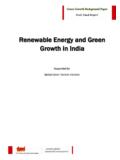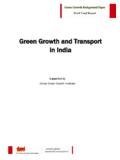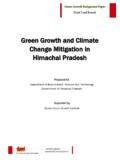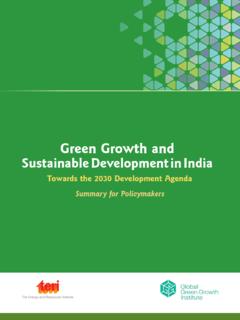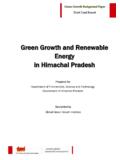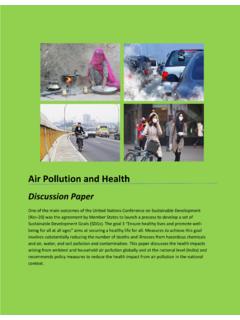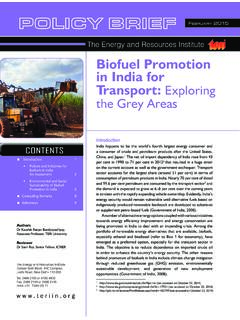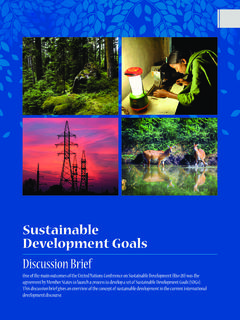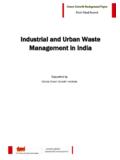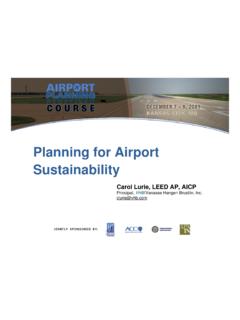Transcription of Green Growth Strategies for Oil and Natural Gas …
1 Green Growth Strategies for Oil and Natural Gas Sector in India Draft Final Report Supported by Global Green Growth Institute Green Growth Strategies for Oil and Natural Gas Sector in India ii The Energy and Resources Institute 2015 Suggested format for citation T E R I. 2015 Green Growth Strategies for Oil and Natural Gas Sector in India New Delhi: The Energy and Resources Institute. 49 pp. Author Saahil M Parekh, Research Associate, TERI Email: Siddharth Singh, Research Associate, TERI Email: Reviewer Kaushik Ranjan Bandyopadhyay, Associate Professor, TERI University Email: For more information Project Monitoring Cell T E R I Tel. 2468 2100 or 2468 2111 Darbari Seth Block E-mail IHC Complex, Lodhi Road Fax 2468 2144 or 2468 2145 New Delhi 110 003 Web i i India India +91 Delhi (0)11 1 Table of contents 1 INTRODUCTION.
2 3 2 AN OVERVIEW OF INDIA S OIL AND GAS SECTOR .. 4 Regulatory institutions and companies .. 5 Taxes and subsidies .. 6 Upstream: Domestic Oil and Gas production .. 7 Oil .. 7 Natural gas .. 9 Midstream: oil and gas pipelines and gas imports infrastructure .. 10 Crude oil pipelines .. 10 Natural gas import infrastructure and pipelines .. 11 Downstream: refining and the final legs of supply .. 12 Refining .. 12 Petroleum product pipelines and fuel retail outlets .. 14 City gas distribution .. 14 3 AVENUES OF Green Growth IN THE OIL AND GAS SECTOR .. 15 Oil and gas supply projections for India .. 16 Reference Energy Scenario (RES) .. 18 Energy Security Scenarios (ESM and ESA) .. 18 Rationale for Green Growth .. 20 Assessing the oil and gas value chain .. 24 Assessing and mitigating environmental risks.
3 25 Clean Development Mechanism .. 28 Initiatives to increase energy efficiency .. 29 Energy efficiency measures in the upstream sector .. 29 Energy efficiency measures in the midstream sector .. 35 Energy efficiency measures in the downstream sector .. 36 Focus on renewables in the oil and gas sector .. 39 Solar energy initiatives .. 40 Wind energy initiatives .. 40 Biofuels and other eco-friendly products .. 41 Sustainable water management Strategies .. 42 Upstream water management Strategies .. 42 Downstream water management Strategies .. 43 4 POLICY ROADMAP .. 43 5 CONCLUSION .. 47 6 BIBLIOGRAPHY .. 48 Green Growth Strategies for Oil and Natural Gas Sector in India 2 List of Tables Table 1: City gas distribution in India (as of March 2014) .. 15 Table 2: World energy-related CO2 emissions abatement.
4 21 Table 3: Direct and indirect emissions of oil and gas companies (in million tCO2e) .. 26 Table 4: World energy supply and consumption by the energy industry in 2011 .. 27 Table 5: India's energy supply and consumption by the energy industry in 2009 .. 27 Table 6: Policy Roadmap for the Oil and Gas Sector .. 46 List of Figures & Boxes Figure 1: Custom and Excise duties on crude and refined petroleum products between 2005-06 and 2012-13 .. 6 Figure 2: The royalties paid on oil and Natural gas, and the oil development cess received from E&P companies .. 7 Figure 3: Petroleum subsidies budgeted by the government of India .. 7 Figure 4: Domestic production and imports of crude oil .. 8 Figure 5: Company-wise domestic crude oil production .. 9 Figure 6: Domestic Natural gas production and LNG imports .. 10 Figure 7: Existing and proposed crude oil pipelines and refineries.
5 11 Figure 8: Production of petroleum products in India .. 12 Figure 9: Existing and planned LNG facilities and pipelines .. 13 Figure 10: CNG sales (as of March 2014) .. 14 Figure 11: World primary energy demand projections .. 16 Figure 12: Projected Domestic Crude Oil Production .. 17 Figure 13: Projected Domestic Natural Gas Production .. 17 Figure 14: India's primary energy supply scenarios Business as usual & energy security scenario .. 20 Figure 15: World energy consumption along the oil and gas supply chain, 2004 .. 24 Figure 16: Gas flared in India (in MMSCM) .. 33 Figure 17: Flaring (in BCM) by ONGC for 2008-09 to 2012-13 .. 34 Figure 18: Emission factors for different modes of transport in the chemicals industry .. 35 Figure 19: EII Index .. 38 Box 1: Carbon Lock-In and the Indian Context .. 4 Box 2: Sustainable development policy of OIL.
6 22 Box 3: GAIL's Sustainability Aspirations 23 Box 4: Snapshot of ONGC's CDM projects (as of March 2013).. 29 Box 5: ONGC s major energy saving initiatives in 31 Box 6: OIL s major energy saving initiatives in 2012-13 .. 31 Box 7: GAIL s major energy saving initiatives in 2012-13 .. 32 Box 8: A few energy saving projects during 2012-13 by IOCL .. 36 Box 9: BPCL s energy savings through increased efficiency .. 37 Box 10: OIL's wind energy investment snapshot .. 41 Green Growth Strategies for Oil and Natural Gas Sector in India 31 Introduction Resource constraints, price volatility and the climate crisis necessitate a serious re-examination of the existing resource- and carbon-intensive Growth Strategies being adopted globally. Asia has been the driver of Growth in the past decade, witnessing a compound annual Growth rate (CAGR) of from 1990 to 2012.
7 It is poised to grow at a rate of up to 2040, with India leading the Growth phenomenon at 6% (IEA, 2014). In order for the region to sustain high economic Growth required to achieve the development goals, while keeping a check on the climate change goals, the regional governments need to chalk out Strategies that improve resource efficiency of energy consumption. Projections have shown that 80% of the reduction in global carbon dioxide (CO2) emissions will come from improving energy efficiency (IPIERCA, 2007). Thus, in order to achieve sustainable economic Growth , improving efficiency and investments in Natural capital should become the drivers (UNESCAP, 2012). From 1990 until 2012, India has witnessed a CAGR of , and its Growth is expected to continue at more or less the same pace up to 2040 (IEA, 2014).
8 However, there are questions about the sustainability of this Growth . Perhaps a pertinent question that needs to be addressed is whether economic Growth has reduced the disparities in income levels in the country, or increased access to energy. There is a strong correlation between human development and per capita energy consumption (TERI, 2014). India, when compared to Brazil, Russia, China, and South Africa, ranks the lowest in Human Development Index (HDI). Similarly, India s scores on the Energy Development Index (EDI), developed by the International Energy Agency (IEA), are also low. India ranks 41st among the 80 countries ranked by IEA in 2012 (TERI, 2014). A study of India s energy sector would be worthwhile under the combined context of sustainability and economic Growth .
9 One of the fundamental principles on which the notion of sustainable development rests is the Environmental Kuznets Curve (Stern, 2003). Theory states that various indicators of environmental degradation tend to get worse with modern economic Growth until average income reaches a certain point over the course of development. A prominent example where this has been observed is China. Its economic Growth pathway has been heavily carbon-intensive and many of the major Chinese cities now suffer from extreme pollution (Kahn & Yardley, 2007). There have been several efforts at a global level focused towards mitigation of climate change, while ensuring economic Growth is not compromised. To do this, a new strategy needs to be formulated which can turn the trade-off between economic development and environmental protection into a win-win synergy in which going Green drives economic Growth .
10 The oil and gas sector of India is one such sector which requires an overhaul. Most of the producing fields in the country have matured and oil production has more or less been stagnant in the last few years. This has led to India s demand being met by imports, which has impacted the state s finances and the nation s energy security, not to mention the unsustainable nature of energy consumption. Further, due to a techno-institutional carbon lock-in of the global economy (see Box 1), the dependence on fossil fuels will remain for decades to come, even after renewables meet grid parity with coal and hydrocarbons. Green Growth Strategies for Oil and Natural Gas Sector in India 4 Under such circumstances, the sector needs to undertake investments in improving production efficiency.
